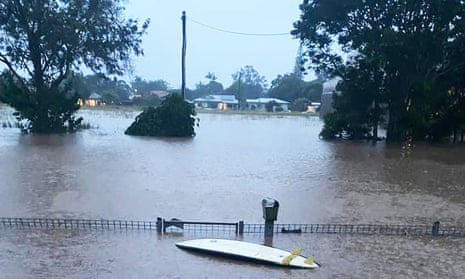Fewer than 60 emergency housing pods are being occupied in northern New South Wales nearly six months after the region was flooded in February. Critics have lambasted the rollout for poor communication, a lack of transparency and one location being built in a flood zone.
Temporary housing measures for flood victims were first announced at the start of March. The NSW government promised in April to provide 2,000 temporary homes including the pods, caravans, motorhomes and accommodation at recreation camps.
But months later, sites at Wardell, Evans Head, Coraki, Kingscliff, Lismore, Ballina and Mullumbimby are still under construction. The government has attributed delays to persistent wet weather.
There are 51 pods operational at Wollongbar, near Lismore, with a further 42 on the way, while a site at Pottsville was handed over to a community housing provider last week to manage 37 caravans. An unknown number of at-home caravans are housing more than 140 residents in Woodburn, Ocean Shores, New Brighton and Byron Bay.
Mullumbimby locals were especially concerned when trouble-plagued Resilience NSW informed them that 60 temporary modular homes were to be placed on vacant crown land in the centre of town, which was inundated during the floods.
Louise Gordon, who lives half a block from the site, said many eligible residents were scared to take up the housing option as they feared it could flood again.
“We are all just so anxious,” Gordon said. “They are putting flood-traumatised people in the flood zone.”
Residents first received notice of the plans for the site on 7 July. Four days later fences had gone up.
While a steady stream of trucks has delivered fill to raise the site above the flood level, Byron Shire councillor Duncan Dey fears the mitigation strategy may cause issues in future flooding events.
Dey – who was a civil engineer specialising in flood analysis before joining local government – said the fill would impact water flows for surrounding properties.
“The placing of fill on a floodplain increases the flooding,” Dey said.
“The extra fill, in my view, I will say quite categorically it will affect those properties east of the railway line. I understand that the government has been saying that there will be no effect and I’ll stand up in court and swear on a Bible that’s incorrect.”
Video shows construction at the Mullumbimby site where truckloads of fill have been brought in to build up the selection crown land above flood level. The area was inundated earlier in the year. pic.twitter.com/z24E3wL53s
— Tamsin Rose (@tamsinroses) August 16, 2022
Dey was on the council when the state government wrote to it earlier this year asking for a list of vacant crown land sites where the pods could be placed.
He said he now regrets not speaking up about the issue when it was first raised and wants to see another solution, as well as the hydrology studies for the site.
The state’s flood recovery minister, Steph Cooke, said the government had worked with councils to “identify and establish temporary housing sites on the limited land available that isn’t at significant flood risk and is located in close proximity to the communities they would service”.
But Ballina Greens MP Tamara Smith said flood victims and local residents deserved better options than to move into “containers on a floodplain”.
She accused the authorities of “cost cutting” by asking the council only for crown land options rather than exploring private or council land.
“There’s a lot of taxpayers dollars have been spent so far. We can do better,” she said.
“On top of all of that, you have no transition plan beyond the two and a half years … It’s a dog’s breakfast.”
Some of the constraints preventing pods from being installed on private property included block size, landowner consent, and the ability to connect utilities or not disrupt site repair work.
Residents near the Kingcliff site told Guardian Australia they had also experienced a lack of consultation and transparency, having had just days of notice before construction started.
Resident Angela Watson said the community had been kept “in the dark” about the project.
“There was no community consultation, no transparency and a lack of notice that this temporary housing project was about to commence,” Watson said.
“What is the state government’s plan to actively help people return to their homes or transition to permanent housing so our most vulnerable are not forgotten?”
The premier, Dominic Perrottet, was handed the report produced after an independent inquiry into the floods – led by Mick Fuller and Mary O’Kane – a fortnight ago. He is expected to hand down his response to the report including a likely dismantling of Resilience NSW and limited land buy-backs on Wednesday.
